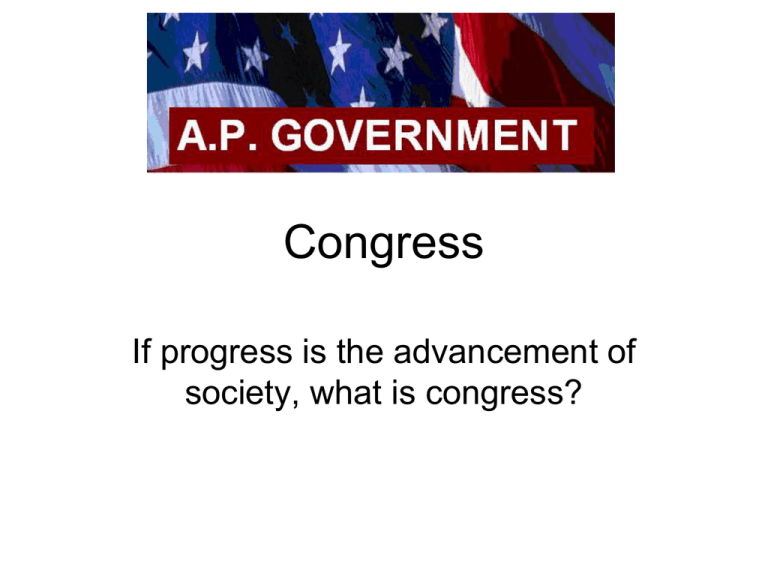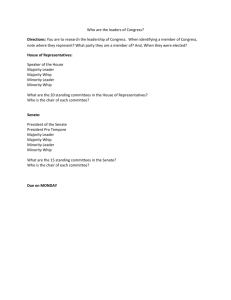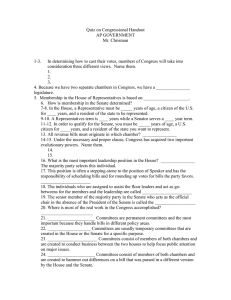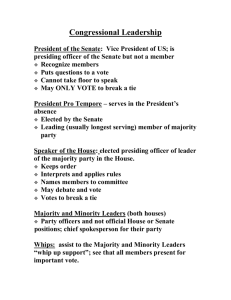Chapter 12
advertisement

Congress If progress is the advancement of society, what is congress? Congress US CAPITOL BUILDING Legislative Branch – “makes laws” Founders’ Intentions 1. Strongest branch 2. Separation of lawmaking power from executive 3. Bicameralism balances large/small states • House – more connected to people (2 yr term) • Senate – allows for independent thinking (6 yr term) Important Differences House • 435 members • 2 year term • 7 year citizen Senate • 100 members • 6 year term • 9 year citizen • Initiate impeachment • Revenue bills • Tries impeachment • Approve presidential appointments • Approve treaties’ • Loose debate rules • Strict debate rules The Representatives and Senators • The Job – Salary of $145,100 with retirement benefits – Office space in D.C. and at home and staff to fill it. – Travel allowances and franking privileges. – But, there’s often 10 to 14 hour days, lots of time away from the family, and lots of pressure from different people to “do the right thing.” Constitutional Powers Article I, Section 8 • To lay and collect taxes, duties, imports • To borrow money • To regulate commerce (states and foreign) • To establish rules for naturalization • To coin money • To create courts (except Supreme Court) • To declare war • To raise and support an army and navy Evolution of Powers Elastic clause has extended Congress powers • Oversight of budget – can restrict the fed. budget prepared by executive branch • Appropriations – set amount of money made available for various activity in a fiscal year • Investigation – Congress can launch investigations (Watergate, Clinton-Lewinski hearings, Steroids in baseball) House Leadership SPEAKER OF THE HOUSE MINORITY LEADER MINORITY WHIP MAJORITY LEADER MAJORITY WHIP Senate Leadership PRESIDENT of the SENATE (VICE PRESIDENT) PRES. PRO TEMPORE MAJORITY LEADER MINORITY LEADER MINORITY WHIP (MOST POWERFUL) MAJORITY WHIP Leadership • Majority party controls the most significant leadership positions • House - Speaker of the House • • • • Allows people to speak on floor Assigns bills to committees Influences which bills are brought to a vote Appoints members of special and select committees • Senate – Majority Leader • Schedules Senate business • Prioritizes bills Who’s in Congress? 110th Congress (2007-2008) • 85% male • 85% White • 40% Lawyers 109th Congress (2005-2006) • 29 accused of spousal abuse • 7 have been arrested for fraud • 19 arrested for writing bad checks • 117 have bankrupted at least 2 businesses • 8 have been arrested for shoplifting • In 1998 alone, 84 were stopped for drunk driving Elections • House members directly elected • Senators directly elected after 17th Amend • House Incumbent advantage – Why? – Name recognition – Proven track record – Franking privileges – free mailing Texas Districts Representation • Malapportionment – unequal population in districts – Wesberry v. Sanders (1963) – found unequal district pop. unconstitutional – 14th amend • Gerrymandering – district boundaries are redrawn in strange ways to make it easy for candidate of one party to win – Easley v. Cromartie (2001) – redistricting for political ideology was constitutional, led to increase in minority reps 12th District How A Bill Becomes a Law • Create legislation, make laws • Founders believed in a SLOW process • Founders believed efficiency was a trait of an oppressive government Step 1 – Introduce Bill • Introduced in Senate or House (except tax) • Single or multiple reps can introduce bill Step 2 - Committee 1. Bill is assigned to a particular committee in its category (Ex. Tax bill – Ways and Means Committee, Farm bill – Agriculture Committee) 2. Bill is then placed in sub-committee 3. Bills are debated and “marked up” 4. Most bills die in committee, committee can vote to “report out” a bill Step 3–Rules Committee • Before bill can go to floor in House, it must first set time limits and amendment regulations. – Closed rule – sets time limits, restricts amendments – Open rule – permits amendments – Restrictive rule – permits some amendments Step 4 – Floor Debate Senate Debate • Less formal, no speaking limit • Filibuster – practice of stalling a bill w/ debate • Cloture – 3/5 of the Senate vote to stop debate House Debate • More formal, no filibuster, strict rules Step 5 - Voting • Majority passes • If the bill passes, it must go through the same process in the opposite chamber with a sponsor • If the bill passes one house and fails the other, it must start over • If the Senate and House cannot come to agreement over two versions, it goes to Conference Committee to fix it and resubmit the bill Presidential Action • Sign – bill becomes law • Veto – bill returns to origin • Override – 2/3 vote in both houses can override veto • Pocket Veto – President has 10 days to act on a piece of legislation. If he receives the bill within 10 days of the end of the Congressional session, and doesn’t sign, it dies Override Committees and Subcommittees • Most real work happens here • Bills are passed, changed, ignored, or killed Types of Committees • Standing committee – handle bills in different policy areas – (ex. Appropriations, Agriculture, Armed Services, Science, etc.) – most important and have been “standing” (existing) for a long time • Select committee – formed for specific purposes and usually temporary – run investigations (ex. Aging, Intelligence) Types of Committees • Joint committee – consist of both House and Senate members – similar in purpose to Select committee – Meant to draw attention to issues • Conference committee – consist of both House reps and Senators – formed to hammer out differences between House and Senate versions of similar bills • Congressional Committees and Subcommittees Committee Membership • Controlled by majority party, committee membership divided proportionally • Committee Chairman – Senior member of committee – Controls membership and debate Work of Committees • 11,000 bills introduced yearly, most die • Committees can… – Report out favorably/unfavorably – Pigeonholed/table (do not discuss) – Amend / “mark up” (change or rewrite) Congressional Caucuses • Groupings of members pushing for similar interests • Ex. – Sunbelt, Northeast-Midwest, Congressional Black, Women’s, Democratic Study Group, Boll Weevils, Steel Criticisms of Congress • “Pork” – aka “pork-barrel legislation” – bills to benefit constituents in hope of gaining their votes • Logrolling – Congress members exchange votes, bills might pass for frivolous reasons • Christmas-tree bill –bill with many riders (pork) – in Senate, no limit exists on amendments, so Senators try to attach riders that will benefit their home state Term-limits Debate • No current limit on how many terms members of Congress can serve 1. Some argue this has weakened popular control of Congress, reps might be unresponsive to their constituents 2. Some argue most experienced reps have the expertise to bring home more benefits (pork, riders, etc.)







